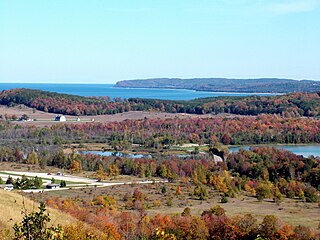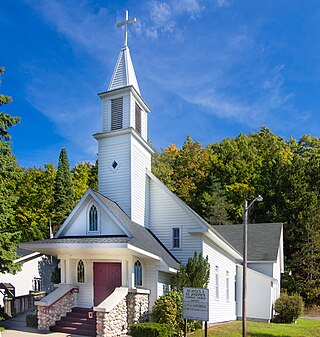History
Empire was founded in 1851. It was incorporated as a village in 1895 with E. R. Dailey, the head of the Empire Lumber Company which was the main employer here, as the first president of the village. [5] The city was named after the schooner "Empire", which was icebound in the city during a storm in 1865.
The Empire Lumber Company operated from 1887 to 1917, dominating this once booming lumber town. George Aylsworth operated the first mill between 1873 and 1883. Potter and Struthers built a second mill in 1885, which T. Wilce Company purchased in 1887. Called the Empire Lumber Company, it expanded to one of the largest and best equipped hardwood mills in the area, capable of producing up to 20 million feet of lumber a year. Docks, several businesses, and a railroad sprang up in Empire. Destroyed by fire in 1906, the mill was quickly rebuilt. The mill burned again in 1917. With most of the nearby virgin timber gone, the mill was not replaced. [6]
The local Robert H. Manning Memorial Light was built in 1991 by O'Brien Brothers Construction as a memorial to Robert H. Manning, a lifelong resident of Empire and avid fisherman. Additionally, the beach has an antique anchor which was discovered by Douglas Manning, son of Robert H. Manning, and Michelle Stryker in 1977. Every year, the village of Empire celebrates the raising of the anchor on the third Saturday in July.
Demographics
2010 census
As of the census [10] of 2010, there were 375 people, 211 households, and 103 families living in the village. The population density was 326.1 inhabitants per square mile (125.9/km2). There were 347 housing units at an average density of 301.7 per square mile (116.5/km2). The racial makeup of the village was 99.2% White and 0.8% Native American. Hispanic or Latino of any race were 0.8% of the population.
There were 211 households, of which 12.8% had children under the age of 18 living with them, 40.8% were married couples living together, 6.2% had a female householder with no husband present, 1.9% had a male householder with no wife present, and 51.2% were non-families. 46.9% of all households were made up of individuals, and 18.4% had someone living alone who was 65 years of age or older. The average household size was 1.78 and the average family size was 2.50.
The median age in the village was 56.8 years. 13.3% of residents were under the age of 18; 2.2% were between the ages of 18 and 24; 16.8% were from 25 to 44; 38.1% were from 45 to 64; and 29.6% were 65 years of age or older. The gender makeup of the village was 45.6% male and 54.4% female.
2000 census
As of the census [2] of 2000, there were 378 people, 187 households, and 104 families living in the village. The population density was 328.5 inhabitants per square mile (126.8/km2). There were 276 housing units at an average density of 239.8 per square mile (92.6/km2). The racial makeup of the village was 98.94% White, 0.26% Native American, 0.26% Asian, and 0.53% from two or more races.
There were 187 households, out of which 16.6% had children under the age of 18 living with them, 47.1% were married couples living together, 5.9% had a female householder with no husband present, and 43.9% were non-families. 39.6% of all households were made up of individuals, and 16.6% had someone living alone who was 65 years of age or older. The average household size was 2.02 and the average family size was 2.70.
In the village, the population was spread out, with 15.6% under the age of 18, 6.3% from 18 to 24, 19.3% from 25 to 44, 35.2% from 45 to 64, and 23.5% who were 65 years of age or older. The median age was 49 years. For every 100 females, there were 94.8 males. For every 100 females age 18 and over, there were 96.9 males.
The median income for a household in the village was $39,722, and the median income for a family was $52,813. Males had a median income of $31,042 versus $24,250 for females. The per capita income for the village was $27,850. About 2.7% of families and 7.4% of the population were below the poverty line, including 7.8% of those under age 18 and 6.0% of those age 65 or over.

Leelanau County is a county located in the U.S. state of Michigan. As of the 2020 census, the population was 22,301. Since 2008, the county seat has been located within Suttons Bay Township, one mile east of the unincorporated village of Lake Leelanau. Before 2008, Leelanau County's seat was Leland. Leelanau County is included in the Traverse City metropolitan area of Northern Michigan. The largest settlement in Leelanau County by population is Greilickville, itself a suburb of Traverse City.

Beverly Shores is a town in Pine Township, Porter County, Indiana, United States, about 36 miles (58 km) east of downtown Chicago. The population was 613 at the 2010 census.

Porter is a town in Westchester Township, Porter County, in the U.S. state of Indiana. The population was 4,858 at the 2010 census. Porter is in the Indiana Dunes ecosystem, which played a role in the creation of The Nature Conservancy, and inspired conservation efforts.

Douglas is a city in Allegan County in the U.S. state of Michigan. The population was 1,378 at the 2020 census. The city is surrounded by Saugatuck Township and the city of Saugatuck is adjacent on the north.

Lake Township is a civil township of Benzie County in the U.S. state of Michigan. The population was 694 at the 2020 census. The township is irregularly shaped, following the shore of Lake Michigan from Crystal Lake north to the border with Leelanau County. A portion of the Sleeping Bear Dunes National Lakeshore is located in the northern end of the township.

Grayling is a city and the county seat of Crawford County in the U.S. state of Michigan. It is the only incorporated community in Crawford County. The population was 1,884 at the 2010 census. The city is surrounded by Grayling Charter Township, but the two are administered autonomously.

Cross Village Township is a civil township of Emmet County in the U.S. state of Michigan. As of the 2020 census, the township population was 240.

Cleveland Township is a civil township of Leelanau County in the U.S. state of Michigan. The population of Cleveland Township was 1,103 at the 2020 census. Part of the township is located within Sleeping Bear Dunes National Lakeshore.

Empire Township is a civil township of Leelanau County in the U.S. state of Michigan. The population was 764 at the 2020 census. On the shores of Lake Michigan, Empire Township contains a substantial amount of land within the Sleeping Bear Dunes National Lakeshore.

Glen Arbor Township is a civil township of Leelanau County in the U.S. state of Michigan. The population was 757 at the 2020 census. However, the population of the town expands rapidly during the summer months as a result of it being a summer colony.

Kasson Township is a civil township of Leelanau County in the U.S. state of Michigan. The population was 1,647 as of the 2020 census. A small portion of the township is included in the Sleeping Bear Dunes National Lakeshore.

Leland Township is a civil township of Leelanau County in the U.S. state of Michigan. As of the early 2000s, the unincorporated community of Leland, which lies totally within the township, was the county seat of Leelanau County. However, county voters on August 3, 2004, approved a proposal to build a new governmental center in adjacent Suttons Bay Township; the move to the new facility was completed in 2008. As of the 2020 census, Leland Township population was 2,126.

Bear Lake is a village in Manistee County in the U.S. state of Michigan. The population was 342 at the 2020 census. The village is located within Bear Lake Township.

Sleeping Bear Dunes National Lakeshore is a U.S. national lakeshore in the northwestern Lower Peninsula of Michigan. Located within Benzie and Leelanau counties, the park extends along a 35-mile (56 km) stretch of Lake Michigan's eastern coastline, as well as North and South Manitou islands, preserving a total of 71,199 acres. The park is known for its outstanding natural features, including dune formations, forests, beaches, and ancient glacial phenomena. The lakeshore also contains many cultural features, including the 1871 South Manitou Island Lighthouse, three former stations of the Coast Guard, and an extensive rural historic farm district.

North Manitou Island is located in Lake Michigan, approximately 12 miles (19 km) west-northwest of Leland, Michigan. It is nearly eight miles long and more than four miles (6 km) wide, with 20 miles (32 km) of shoreline. It has a land area of 57.876 km2 and has no population. The smaller South Manitou Island lies to its southwest.

South Manitou Island is located in Lake Michigan, approximately 16 miles (26 km) west of Leland, Michigan. It is part of Leelanau County and the Sleeping Bear Dunes National Lakeshore. The uninhabited island is 8.277 sq mi (21.44 km2) in land area and can be accessed by a ferry service from Leland. Guided tours on open-air vehicles are available to visitors, but most traffic is on foot. Larger North Manitou Island lies to its north.

Leland is an unincorporated community and census-designated place (CDP) in the U.S. state of Michigan. It is located in Leelanau County, part of the northwestern Lower Peninsula of the state. As of the 2020 census it had a population of 410. From 1883 to 2004, Leland was the county seat of Leelanau County, which has since moved to Suttons Bay Township.

Glen Arbor is an unincorporated community and census-designated place in Glen Arbor Township, Leelanau County, Michigan, United States. A small tourist town, Glen Arbor lies on an isthmus between Lake Michigan and Glen Lake. It is adjacent to Sleeping Bear Dunes National Lakeshore.

Glen Haven is a restored port village on the shore of Lake Michigan on the Leelanau Peninsula within the now Sleeping Bear Dunes National Lakeshore. Attractions include the Lake Michigan beach, a restored General Store and Blacksmith Shop. The unincorporated community is located in Glen Arbor Township.
Arcadia Township is a civil township of Manistee County in the U.S. state of Michigan. As of the 2020 census, the township population was 657.

























